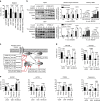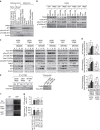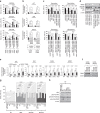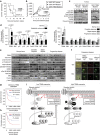TRIB2 confers resistance to anti-cancer therapy by activating the serine/threonine protein kinase AKT
- PMID: 28276427
- PMCID: PMC5347136
- DOI: 10.1038/ncomms14687
TRIB2 confers resistance to anti-cancer therapy by activating the serine/threonine protein kinase AKT
Retraction in
-
Retraction Note: TRIB2 confers resistance to anti-cancer therapy by activating the serine/threonine protein kinase AKT.Nat Commun. 2023 Jul 19;14(1):4341. doi: 10.1038/s41467-023-40050-1. Nat Commun. 2023. PMID: 37468494 Free PMC article. No abstract available.
Abstract
Intrinsic and acquired resistance to chemotherapy is the fundamental reason for treatment failure for many cancer patients. The identification of molecular mechanisms involved in drug resistance or sensitization is imperative. Here we report that tribbles homologue 2 (TRIB2) ablates forkhead box O activation and disrupts the p53/MDM2 regulatory axis, conferring resistance to various chemotherapeutics. TRIB2 suppression is exerted via direct interaction with AKT a key signalling protein in cell proliferation, survival and metabolism pathways. Ectopic or intrinsic high expression of TRIB2 induces drug resistance by promoting phospho-AKT (at Ser473) via its COP1 domain. TRIB2 expression is significantly increased in tumour tissues from patients correlating with an increased phosphorylation of AKT, FOXO3a, MDM2 and an impaired therapeutic response. This culminates in an extremely poor clinical outcome. Our study reveals a novel regulatory mechanism underlying drug resistance and suggests that TRIB2 functions as a regulatory component of the PI3K network, activating AKT in cancer cells.
Conflict of interest statement
All authors declare that there are no competing financial interests except N.L. who is an employee of Bayer AG.
Figures




References
-
- Berns K. et al.. A large-scale RNAi screen in human cells identifies new components of the p53 pathway. Nature 428, 431–437 (2004). - PubMed
-
- Lam E. W., Brosens J. J., Gomes A. R. & Koo C. Y. Forkhead box proteins: tuning forks for transcriptional harmony. Nat. Rev. Cancer 13, 482–495 (2013). - PubMed
-
- Brunet A. et al.. Akt promotes cell survival by phosphorylating and inhibiting a Forkhead transcription factor. Cell 96, 857–868 (1999). - PubMed
Publication types
MeSH terms
Substances
LinkOut - more resources
Full Text Sources
Other Literature Sources
Molecular Biology Databases
Research Materials
Miscellaneous

